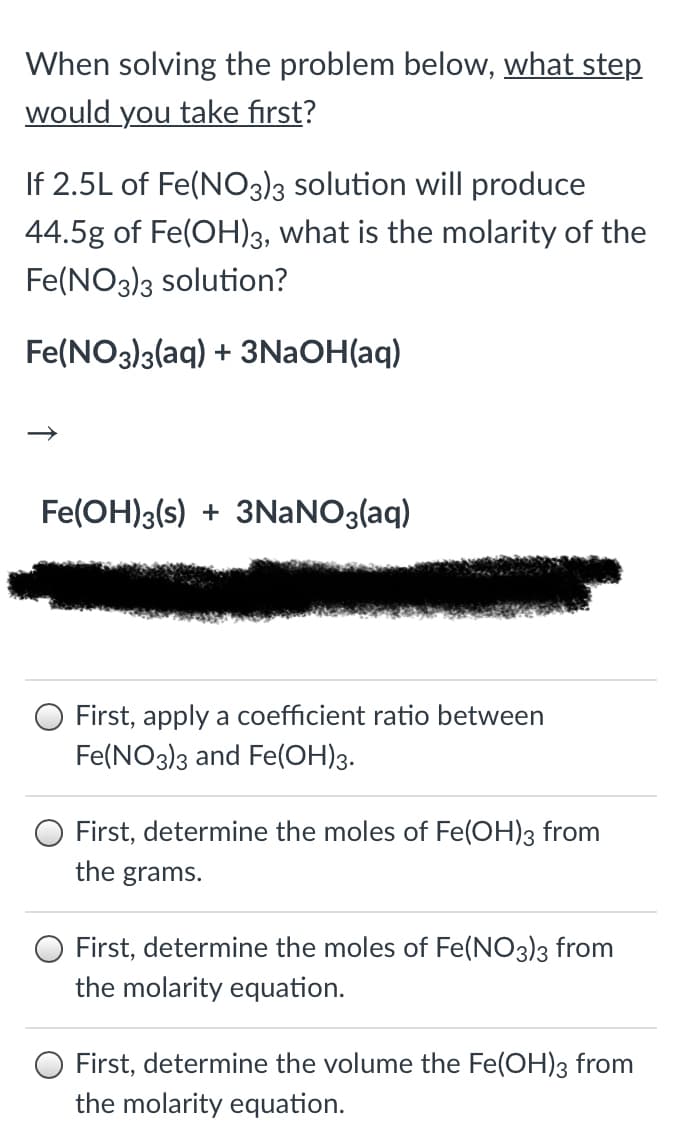When solving the problem below, what step would you take first? If 2.5L of Fe(NO3)3 solution will produce 44.5g of Fe(OH)3, what is the molarity of the Fe(NO3)3 solution? Fe(NO3)3(aq) + 3NAOH(aq) Fe(OH)3(s) + 3NANO3(aq) First, apply a coefficient ratio between Fe(NO3)3 and Fe(OH)3. First, determine the moles of Fe(OH)3 from the grams. First, determine the moles of Fe(NO3)3 from the molarity equation. First, determine the volume the Fe(OH)3 from the molarity equation.
When solving the problem below, what step would you take first? If 2.5L of Fe(NO3)3 solution will produce 44.5g of Fe(OH)3, what is the molarity of the Fe(NO3)3 solution? Fe(NO3)3(aq) + 3NAOH(aq) Fe(OH)3(s) + 3NANO3(aq) First, apply a coefficient ratio between Fe(NO3)3 and Fe(OH)3. First, determine the moles of Fe(OH)3 from the grams. First, determine the moles of Fe(NO3)3 from the molarity equation. First, determine the volume the Fe(OH)3 from the molarity equation.
Chemistry & Chemical Reactivity
10th Edition
ISBN:9781337399074
Author:John C. Kotz, Paul M. Treichel, John Townsend, David Treichel
Publisher:John C. Kotz, Paul M. Treichel, John Townsend, David Treichel
Chapter1: Basic Concepts Of Chemistry
Section: Chapter Questions
Problem 49RGQ: Fluoridation of city water supplies has been practiced in the United States for several decades. It...
Related questions
Question

Transcribed Image Text:When solving the problem below, what step
would you take first?
If 2.5L of Fe(NO3)3 solution will produce
44.5g of Fe(OH)3, what is the molarity of the
Fe(NO3)3 solution?
Fe(NO3)3(aq) + 3NAOH(aq)
Fe(OH)3(s) + 3NANO3(aq)
First, apply a coefficient ratio between
Fe(NO3)3 and Fe(OH)3.
O First, determine the moles of Fe(OH)3 from
the grams.
First, determine the moles of Fe(NO3)3 from
the molarity equation.
First, determine the volume the Fe(OH)3 from
the molarity equation.
Expert Solution
This question has been solved!
Explore an expertly crafted, step-by-step solution for a thorough understanding of key concepts.
This is a popular solution!
Trending now
This is a popular solution!
Step by step
Solved in 2 steps

Knowledge Booster
Learn more about
Need a deep-dive on the concept behind this application? Look no further. Learn more about this topic, chemistry and related others by exploring similar questions and additional content below.Recommended textbooks for you

Chemistry & Chemical Reactivity
Chemistry
ISBN:
9781337399074
Author:
John C. Kotz, Paul M. Treichel, John Townsend, David Treichel
Publisher:
Cengage Learning

Chemistry: The Molecular Science
Chemistry
ISBN:
9781285199047
Author:
John W. Moore, Conrad L. Stanitski
Publisher:
Cengage Learning

Chemistry: Principles and Practice
Chemistry
ISBN:
9780534420123
Author:
Daniel L. Reger, Scott R. Goode, David W. Ball, Edward Mercer
Publisher:
Cengage Learning

Chemistry & Chemical Reactivity
Chemistry
ISBN:
9781337399074
Author:
John C. Kotz, Paul M. Treichel, John Townsend, David Treichel
Publisher:
Cengage Learning

Chemistry: The Molecular Science
Chemistry
ISBN:
9781285199047
Author:
John W. Moore, Conrad L. Stanitski
Publisher:
Cengage Learning

Chemistry: Principles and Practice
Chemistry
ISBN:
9780534420123
Author:
Daniel L. Reger, Scott R. Goode, David W. Ball, Edward Mercer
Publisher:
Cengage Learning